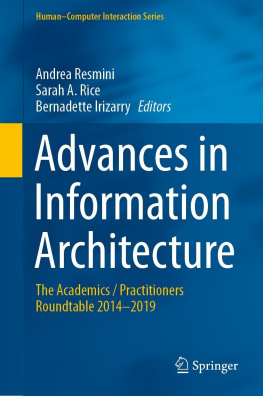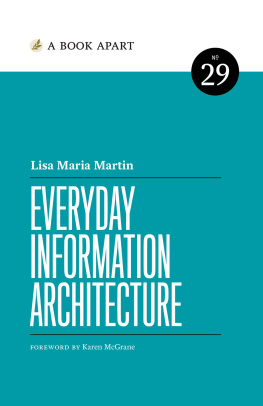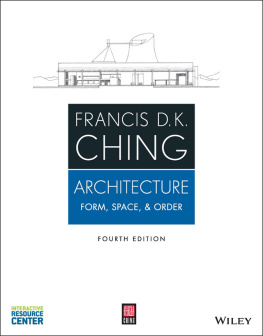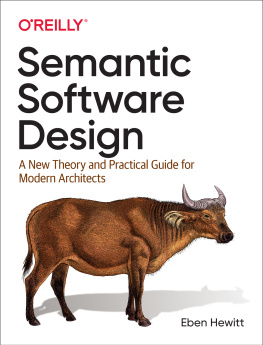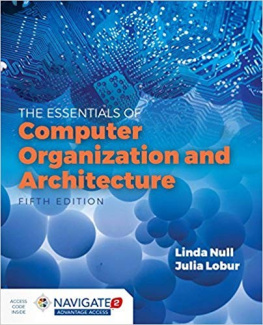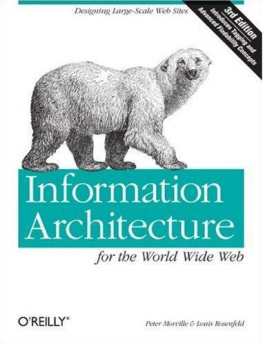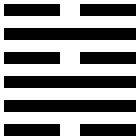Information Architecture
by Louis Rosenfeld , Peter Morville , and Jorge Arango
Copyright 2015 Jorge Arango, Peter Morville, and Louis Rosenfeld. All rights reserved.
Printed in the United States of America.
Published by OReilly Media, Inc. , 1005 Gravenstein Highway North, Sebastopol, CA 95472.
OReilly books may be purchased for educational, business, or sales promotional use. Online editions are also available for most titles ( http://safaribooksonline.com ). For more information, contact our corporate/institutional sales department: 800-998-9938 or corporate@oreilly.com .
- Acquisitions Editor: Mary Treseler
- Editor: Angela Rufino
- Production Editor: Matthew Hacker
- Copyeditor: Jasmine Kwityn
- Proofreader: Rachel Head
- Indexer: Judith McConville
- Interior Designer: David Futato
- Cover Designer: Karen Montgomery
- Illustrator: Rebecca Demarest
- September 2015: Fourth Edition
Revision History for the Fourth Edition
- 2015-08-25: First Release
See http://oreilly.com/catalog/errata.csp?isbn=9781491911686 for release details.
The OReilly logo is a registered trademark of OReilly Media, Inc. Information Architecture, the cover image, and related trade dress are trademarks of OReilly Media, Inc.
While the publisher and the authors have used good faith efforts to ensure that the information and instructions contained in this work are accurate, the publisher and the authors disclaim all responsibility for errors or omissions, including without limitation responsibility for damages resulting from the use of or reliance on this work. Use of the information and instructions contained in this work is at your own risk. If any code samples or other technology this work contains or describes is subject to open source licenses or the intellectual property rights of others, it is your responsibility to ensure that your use thereof complies with such licenses and/or rights.
978-1-491-91168-6
[FILL IN]
Preface
The town may be changed,
But the well cannot be changed.
It neither decreases nor increases.
They come and go and draw from the well.
I Ching
The first edition of this book then titled Information Architecture for the World Wide Web was published in 1998. This was a full 9 years before the iPhone changed the way we share pictures of our kids with our family and friends, 6 years before Facebook reintroduced long-forgotten high school friends into our lives, 6 years before the term folksonomy was coined (and 10 years before its currency devalued), and 12 or so years before many of us first heard the term Internet of Things. There was no Web 2.0 back then; we were still trying to figure out Web 1.0!
Those of us who have been structuring and designing websites since the early days have experienced astonishing changes in our industry. Weve seen the underlying technologies of the mediumincluding HTML itself, along with JavaScriptevolve from what were at first primitive content-delivery mechanisms into full-featured interactive application stacks. Weve seen device form factors evolve from indirect experiences where we control an abstract pointer with a mouse, to the direct, intimate experience of manipulating information by touching elegant slabs of glass with our fingers. Weve seen Internet access go from being a slow, discreet activity that we engaged in by sitting at a desk, in front of a bulky computer tethered to a copper wire, to something we do everywhere at any time by pulling out a blazing fast, sensor- and camera-laden minicomputer/telephone from our pocket. And now weve started to see that power permeate into everyday objects and environments, fundamentally transforming everyday experiences weve long taken for granted. Change is relentless, ubiquitous, exhilaratingand a little scary.
One constant amidst all this change is that every year humanity produces and consumes more information than before. This information glut can make it increasingly challenging for people to find the stuff theyre looking for, and make sense of it once they doespecially now that users can interact with information using a wide range of devices and services. Information architecture is the area of practice that helps alleviate this problem. The concepts, methodologies, and techniques that have been so effective in structuring websites can also be applied to broader, more heterogeneous information ecosystems such as those we have today.
Earlier editions of this book were focused on one type of such information ecosystems: websites (in their various manifestations, including intranets and corporate portals.) This fourth edition has a new subtitle: For the Web and Beyond. This is an acknowledgement that the information ecosystem landscape is richer and more complex today. Many peoples experience of interacting with information increasingly occurs via smartphone apps and other channels that do not involve a traditional web browser. Additionally, as system components and sensors keep getting smaller and cheaper, two-way access to information is becoming a key part of everyday objects like thermostats and doorknobs, which arent perceived as traditional computing devices at all. While many of these experiences will not require the same types of semantic structures that traditional websites did, they are still key components in information ecosystems and thus subject to many of the same design principles presented in previous editions of the book. When considering the subject of our designs in the abstractas information environments instead of websiteswe can see that the design principles that inform these semantic structures have broad applicability beyond design for the Web.
The I Ching is an ancient Chinese oracle, and arguably the oldest interactive information environment in the world. Its text presents 64 patterns that describeand teach how to deal withdifferent aspects of change. One of these patterns, The Well, represents those things in life that are constant and which steadfastly replenish and refresh us, even as the chaos of impermanence alters the world around us. We have approached this fourth edition of the polar bear book with the recognition that information architecture is one such well: as long as we are dealing with the design of information environments for use by human beings, we will have a need for tools and techniques that allow us to structure that information to make it easy to find and understand. We have gone back to first principles to identify those that can be used in any situation to help bring consistency, coherence, and understandability to digital products and services, regardless of their manifestations in space and time. Our hope is that even as technologies and techniques come and go, you will be able to continue drawing from the well of information architecture for many years to come.
Whats New in the Fourth Edition
Information Architecture for the Web and Beyond focuses on information architecture as a set of tools and techniques for dealing with tough information organization problemsfor anyone involved in any aspect of design, regardless of their job title. We have gone through the first three editions and brought forward those principles of information organization that are universal and timeless. Weve cast these in the context of current practice by updating the examples and illustrations. Weve avoided discussions of particular software packages; its all changing too quickly for this information to have much value in the long term. Instead, weve focused on tools and techniques that have stood the test of time and which are not dependent on particular technologies or vendors. Finally, weve updated the Appendix to include the most useful information architecture resources available today.


